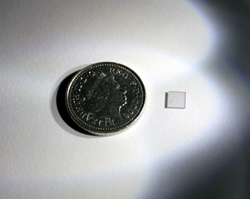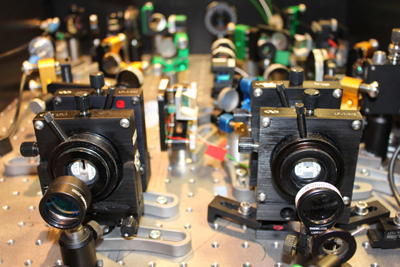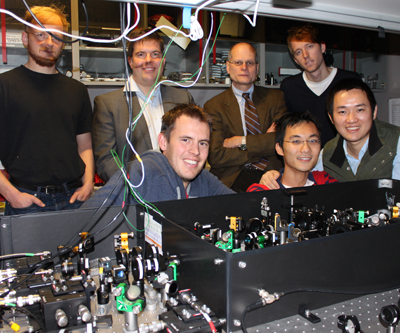Highlights
Diamonds entangled at room temperature: paper in Science

The diamond crystals in the experiment measured 3mm square — pictured here with a British ten-pence coin for scale.
Quantum physics doesn't only describe the antics of tiny particles. In the most recent demonstration of counterintuitive quantum effects creeping into the macroscopic world, researchers have created and measured quantum entanglement between two diamond crystals at room temperature.
A team based at the UK's University of Oxford, including two researchers affiliated with the Centre for Quantum Technologies, Dieter Jaksch and Xian-Min Jin, carried out the experiment. The team describes the result in a paper published 2nd December in Science. The work also features in a Perspective in Science by Luming Duan of the University of Michigan and in many news stories (see list at end).
"This work pushes the boundary of the quantum manipulation of massive objects in ambient environment conditions," says Xian-Min, who is a Research Fellow at CQT and postdoc in Oxford in a joint-appointment scheme that encourages collaboration, "it offers a glimpse into the transition between the quantum and classical realms".
The researchers estimate that approximately one nanocarat (10-9 carats) from each diamond was entangled with one nanocarat from the other. Though minuscule by romantic standards, a nanocarat contains approximately 1016 carbon atoms and would be large enough to see by eye.
Entanglement unites two objects in a shared quantum state, linking their properties in a way that transcends the separation between them. In this experiment, two diamond crystals 15 cm apart were entangled in a shared vibrational state that describes one crystal vibrating and the other not-vibrating but doesn't determine which is which. In this state, neither crystal can be described definitively as either vibrating or not-vibrating.

Diamonds may be forever, but their entanglement lasts only picoseconds (10-12 seconds). The team used an optical setup exploiting femtosecond (10-15 second) laser pulses to create and detect the entanglement.
Diamond is considered a promising material for quantum technologies. For example, the long-lived quantum states of atoms trapped in diamond (N-V centres) have been proposed for use in sensors and information processing devices. This work is the first to exploit the bulk properties of diamond to demonstrate quantum effects, and the group has conceived schemes to scale up such effects into fast, high capacity quantum memory chips. However, for now, the result stands out most as an observation of quantum phenomena in a solid, everyday object at room temperature.
Over the past few years, researchers have shown quantum effects such as entanglement and superposition in increasingly large systems. These systems include molecules containing hundreds of atoms and miniature cantilevers cooled to temperatures near absolute zero.

Pictured are researchers (left-right, back row) Patrick Michelberger, Dieter Jaksch, Ian Walmsley, Michael Sprague and (front row) Duncan England, Ka Chung Lee, Xian-Min Jin.
Two factors were key to the Oxford group being able to see entanglement at room temperature. Firstly, being such a hard material, diamond is difficult to set vibrating. This means that such vibrations cannot be created spontaneously by thermal energy (which would disrupt the experiment), and that the vibrations the team create are not subject to thermal noise. Secondly, the group was quick. Although the vibrational state itself is short lived, the Oxford group was able to create and "catch" it using ultrafast femtosecond (10-15 second) pulses.
How did this work? First a femtosecond laser pulse, divided to shine on both diamonds, would with some probability create a vibrational state — technically, excite a phonon — in one of the diamonds, simultaneously causing it to emit a photon. By passing that emitted photon through optics that disguises which crystal it came from, the two diamonds become entangled. The entanglement is then confirmed by measuring a second photon emitted by the diamonds, triggered by a second laser pulse.
Dieter, who is a CQT Visiting Research Professor, heads a quantum theory group at the University of Oxford. His group has collaborated with experimentalists in the group of Professor Ian Walmsley, who led the current work, on exploration of technologies for quantum memories. Xian-Min Jin contributed to designing the experiment, to laboratory measurements and to data analysis. The paper's authors also include a researcher from the National Research Council of Canada. Some of the 12-strong team are pictured above.
For more details, see the paper "Entangling Macroscopic Diamonds at Room Temperature" Science 334, 1253 (2011).
Coverage in the media:
- CBC News: Gem-sized diamonds open quantum computing doors
- InsideScience: In the Quantum World, Diamonds Can Communicate With Each Other
- LiveScience: Two Diamonds Linked by Strange Quantum Entanglement (and comments on reddit.com)
- Nature: Entangled diamonds vibrate together
- New Scientist: Entangled diamonds blur quantum-classical divide
- Oxford Science Blog: Vibration rocks for entangled diamonds
- Physics World: Diamonds entangled at room temperature
- POPSCI: Researchers Entangle Two Millimeter-Sized Diamonds, A Huge Leap in the Scale of Quantum Entanglement
- Popular Mechanics: Spooky Quantum Entanglement Created in Everyday Objects
- Science: Perspective: Quantum Correlation Between Distant Diamonds
- Scientific American: Quantum Entanglement Links Two Diamonds
- The Register: Quantum computing comes closer as diamonds get spooky
- Vancouver Sun: Diamonds a step toward much faster computers






